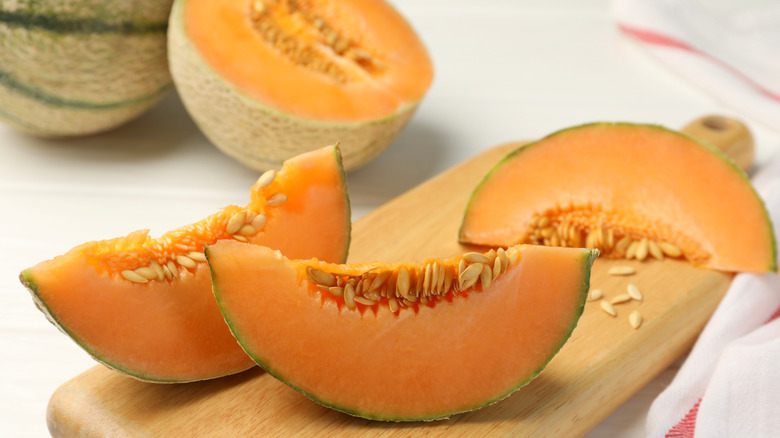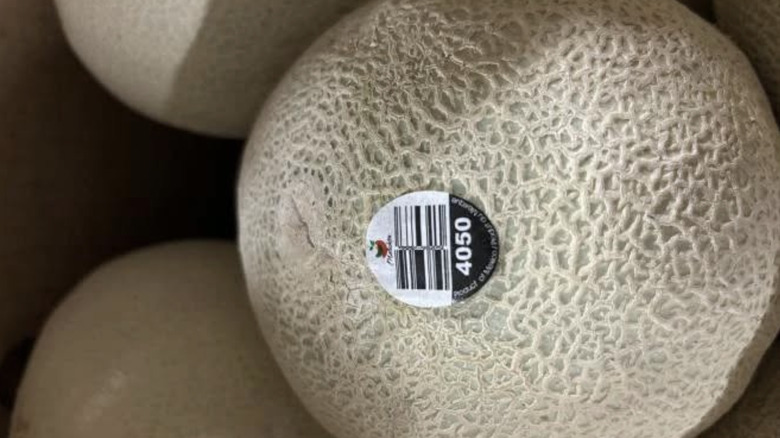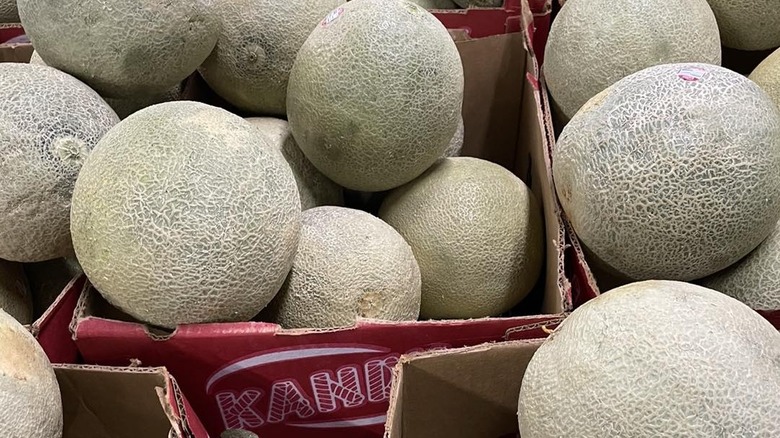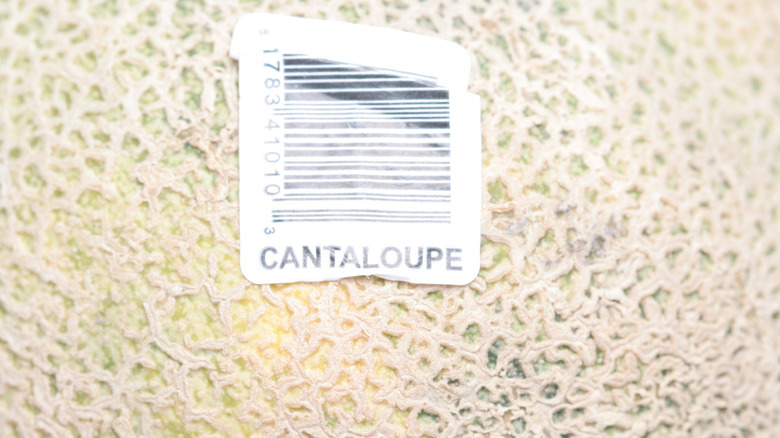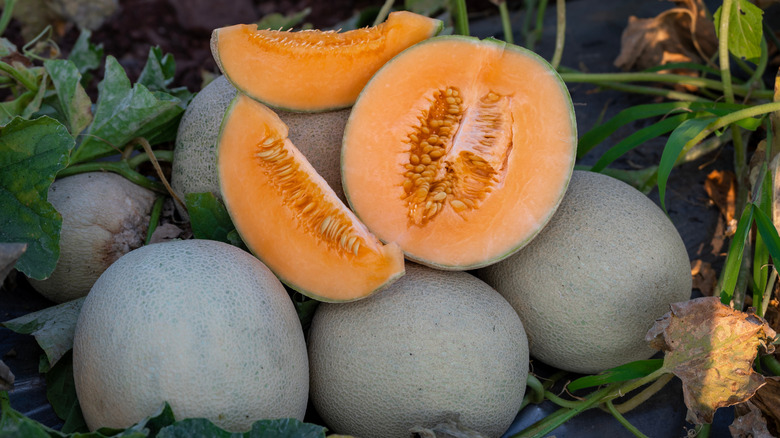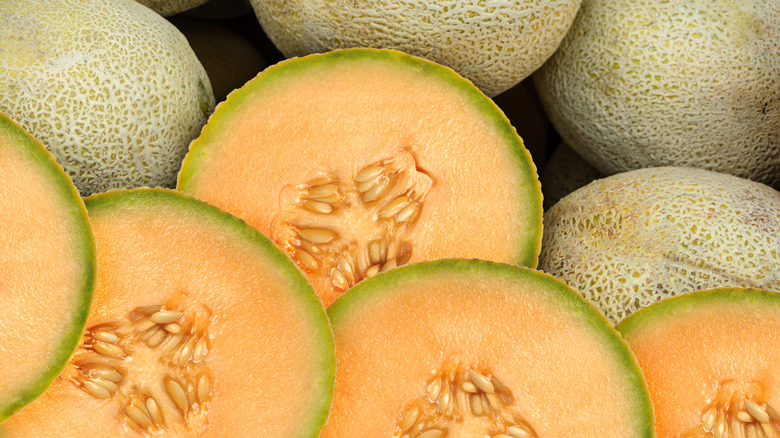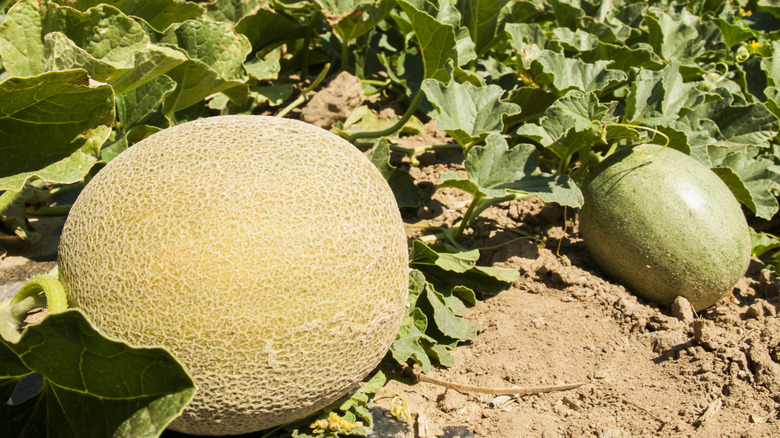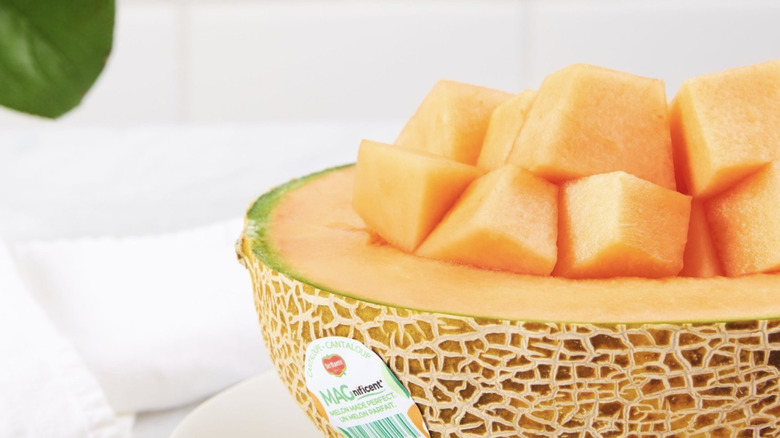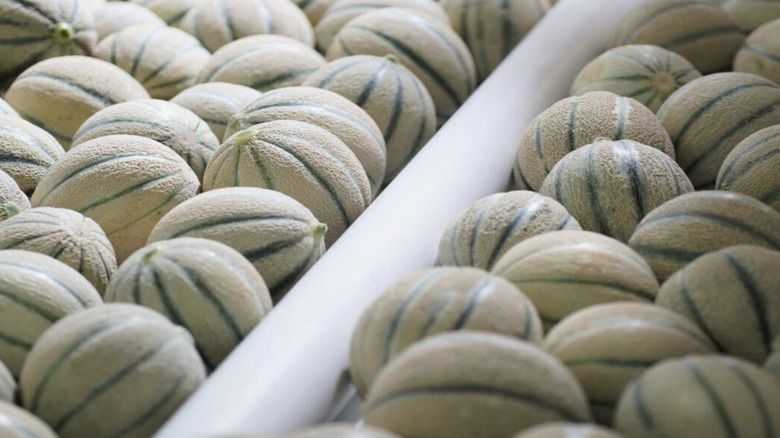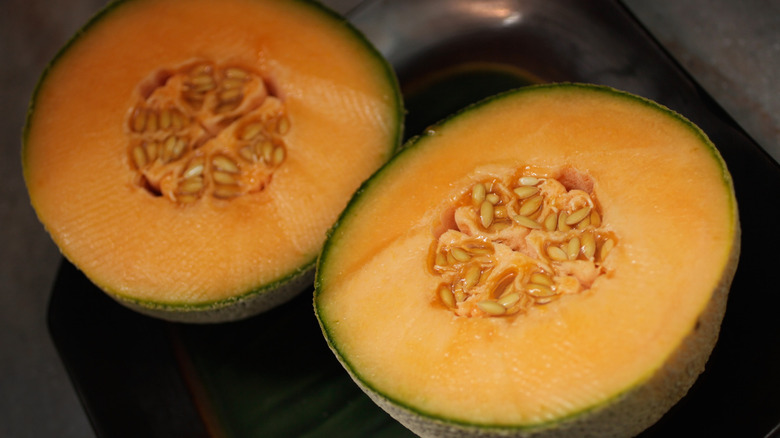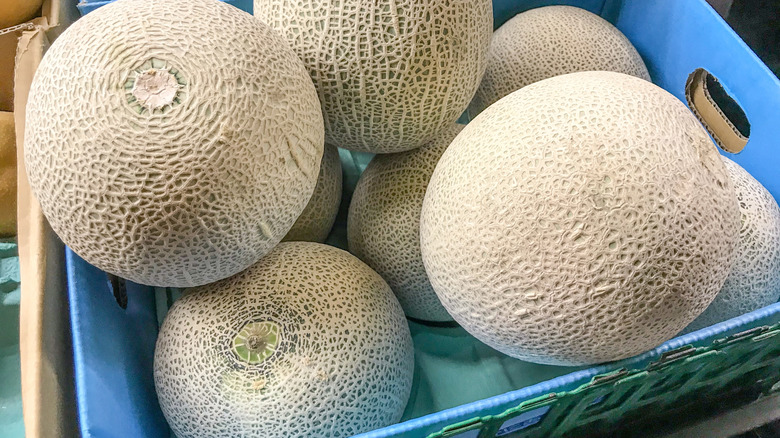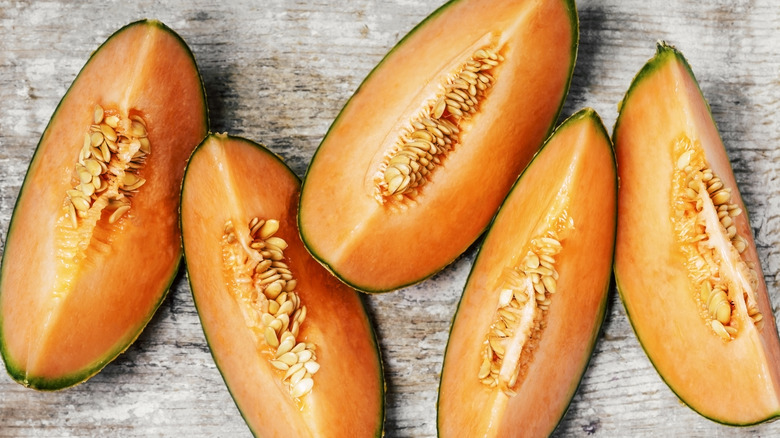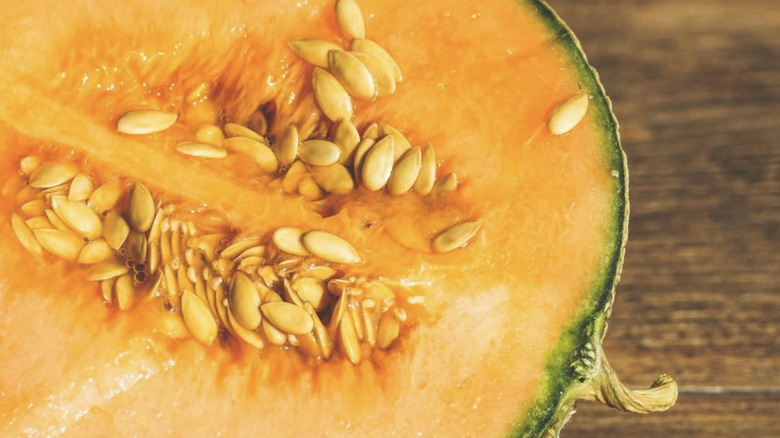The Biggest Cantaloupe Recalls In US History
When you think about the most dangerous foods to eat, cantaloupe probably isn't the first one that comes to mind. It would be far more obvious to worry about widely consumed items, like contaminated fast food or eggs that end up being recalled. Yet, truth be told, this sweet orange melon has been behind more than one of the deadliest recalls in U.S. history. Why? Cantaloupe sold in the U.S. has a tragic tendency to be tainted by various foodborne pathogens. Since the fruit is typically served fresh, certain strains that would otherwise be killed by a high enough cooking temperature live on within cantaloupe. A lot of cantaloupe recalls due to these pathogenic contaminants have been big, and far too many of them have killed people.
For those who enjoy cantaloupe, the recall statistics over the past few decades are hard to see. Recently, the cantaloupe supply on the West Coast has exceeded demand. This waning interest in cantaloupe may be the lingering aftershock from a particularly devastating recall that occurred in 2023 (more on that in a little bit). Either way, the biggest lesson to be learned from cantaloupe recalls is that more needs to be done by growers and distributors so that dangerous cantaloupe stays out of public reach.
The United States Department of Agriculture (USDA) and the U.S. Food and Drug Administration (FDA) are the federal agencies responsible for keeping contaminated or unregulated goods from entering the domestic market. As you'll see here, this is a work in progress. These are cantaloupe recalls that shook U.S. fruit lovers to their core.
Malichita cantaloupe in 2023
Rumblings of an uneasy situation were afoot in November 2023 when the FDA teamed up with the Centers for Disease Control and Prevention (CDC) to investigate a string of salmonellosis clusters actively occurring in the U.S. and Canada. Canadian health authorities used Whole Genome Sequencing (WGS) analysis to link clinical samples of the salmonella strain Sundsvall taken from those who fell ill with salmonella-laden cantaloupes that had been imported into the country from Mexico under the "Malichita" and "Rudy" labels. One U.S. cantaloupe seller, Sofia Produce, recalled its supply early that month.
The FDA announced a public health alert to U.S. consumers regarding the dangers surrounding Malichita cantaloupe. Within days, multiple brands, including Pacific Trellis Fruit and Crown Jewel Produce Company, recalled hundreds of thousands of pounds of Malichita cantaloupe from the U.S. market. These recalls didn't happen soon enough. By November 29, 2023, the CDC reported 117 cases of salmonellosis had spread across 34 states. Worse yet, Canadian health inspectors had identified a second strain, Salmonella Oranienburg, in Malichita cantaloupe. Multiple people in the U.S. had already been sickened from it.
By January 2024, health officials concluded their investigation, but tragedy had spread far and wide. Canada reported 68 hospitalizations and nine deaths. Of the 407 reported illnesses in the U.S., 158 people were hospitalized. Six of them died.
Eagle Produce cantaloupe in 2023
About a month before what would be one of the deadliest cantaloupe recalls in history, Eagle Produce of Scottsdale, Arizona, was experiencing a serious problem of its own. In September 2023, the FDA conducted testing on some of Eagle Produce's Kandy cantaloupes at a distribution center and found that they were positive for salmonella bacteria. Eagle Produce issued a voluntary recall for three lots of its whole cantaloupe on September 23.
Unfortunately, the contaminated fruit had already been shipped to 19 states, and Washington D.C. Eagle Produce sold Kandy cantaloupe in various grocery stores all over the country. The amount of recalled cantaloupe comprised 6,456 cases. The compromised melons were distributed between September 15 and 16, 2023. One positive that came out of this humongous recall was that no reported illnesses were ever connected to Eagle Produce's faulty product. It was a lucky break. By the beginning of 2024, a salmonella outbreak related to cantaloupe imported from Mexico would leave 15 people dead.
DFI Marketing Inc. cantaloupe in 2012
Cantaloupe was on the USDA's radar by 2012, and in September of that year, DFI Marketing Inc., based in Fresno, California, was on the federal radar. Health inspectors tested some of DFI's cantaloupe at a wholesale distribution center and detected salmonella. Upon receiving the news, DFI didn't hesitate to issue a mass cantaloupe recall. Although DFI's in-house product testing hadn't turned up any foodborne pathogens prior to the USDA's findings, the company pulled approximately 28,000 cartons of cantaloupe from distribution out of an abundance of caution.
The tainted cantaloupe was packed on August 26, 2012, and had already made their way to retail markets in 22 states. The recalled cartons contained anywhere between six to 18 cantaloupes per package, which meant that a minimum of 168,000 cantaloupes were implicated in the recall. As tough as it may have been for DFI to lose that much product, at least no reports of salmonellosis were connected to the contaminated melons.
Chamberlain Farm Produce cantaloupe in 2012
By 2012, media coverage of the profound dangers associated with tainted cantaloupe had the nation on edge. That August, it was more bad news — Chamberlain Farms of Owensville, Indiana, was recalling all of its cantaloupes. The melons were connected with an ongoing salmonella outbreak that had sickened 178 people. When the CDC concluded its investigation of the outbreak in October 2012, a total of 261 reported salmonella infections and 94 hospitalizations had been reported in 24 states, including three deaths in Kentucky.
Salmonella Typhimurium and Salmonella Newport were both traced back to Chamberlain Farms. Investigators used pulsed-field gel electrophoresis (PFGE) testing and Multiple-Locus Variable-number tandem repeat Analysis (MLVA) to match the bacterial strain in Salmonella Typhimurium patients with the one found in cantaloupe from Chamberlain Farms. FDA investigators who visited Chamberlain Farms identified the same strain on surface areas on the property. Samples of Chamberlain Farms' cantaloupe and watermelon that tested positive for Salmonella Newport had indistinguishable PFGE patterns to the strain responsible for the outbreak.
During the inspection of Chamberlain Farms, FDA investigators witnessed unsanitary processing conditions. Dirty conveyor belts and rusty equipment were among the health code violations cited during inspection. In 2013, an attorney for Chamberlain Farms stated that cantaloupes were not part of the farms' growing season inventory and that its cantaloupe processing equipment had been disposed of.
Burch Equipment LLC cantaloupe in 2012
In July 2012, North Carolina melon grower Burch Equipment LLC was on the FDA's bad side after random testing of its cantaloupe returned a positive result for listeria monocytogenes. Between July 28 and August 2, 2012, the company recalled 14,468 cases of cantaloupe due to the contamination. The number of recalled melons totaled 188,902. On August 3, 2012, Burch Equipment issued a revision to the recall, specifying that its Caribbean Gold cantaloupe was the variety affected and its Athena cantaloupe hadn't. This would not be the only recall correction Burch Farms had to make.
On August 10, 2012, Burch Equipment announced a recall expansion to include all of the cantaloupe and honeydew from the growing season. The expansion was based on FDA testing of Burch Equipment honeydew melon, which was also positive for listeria. The melons were sold in 18 states.
While the recall was not linked to a listeriosis outbreak or any reports of illness, the FDA's visit to Burch Farms in Faison, North Carolina, did not go well. The FDA observed unsanitary conditions inside the packing shed, which investigators pointed to as the likely origin of the listeria bacteria. After the recall, Burch Farms co-owner Jimmy Burch, who maintained that the facility had followed food safety protocol, said, "That part of our life is over with. We will let someone else raise the cantaloupe. We have already towed the equipment out of the building. It's not worth the liability" (via barfblog).
Jensen Farms cantaloupe in 2011
No other recall is more synonymous with the deadly effects of unregulated cantaloupe than the one that came out of Jensen Farms. The family-run Colorado farm took shortcuts in its manufacturing process circa May 2011, and the results were catastrophic. Brothers Eric and Ryan Jensen, who oversaw the farm, installed a secondhand cleaning system designed for potatoes to process the Rocky Ford cantaloupes grown on the farm. A catch pan with a chlorine spray that was supposed to be incorporated into the machinery was never implemented.
The Jensens knew that washing the cantaloupe with anti-microbial spray would lower the risk of pathogens contaminating the fruit but distributed at least six shipments of improperly cleaned cantaloupe anyway. This decision resulted in cantaloupe being full of listeria monocytogenes, causing a full-fledged outbreak and being recalled from 28 states. Nearly 150 people were hospitalized, and 33 died. The Jensens faced criminal charges for introducing adulterated food into interstate commerce.
The brothers pleaded guilty and managed to avoid prison time due to cooperating with the investigation (much to the dismay of some victims' family members). Each Jensen received six months of house arrest and five years probation. They also were ordered to pay $150,000 to the families of the deceased (when only three families asked for restitution, the figure was reduced to $13,184). It was the deadliest foodborne outbreak in the U.S. in almost a century, and like any tragedy involving human error, it was completely preventable.
Del Monte Fresh Produce cantaloupe in 2011
The Del Monte Fresh Produce cantaloupe recall in March 2011 was a foreshadowing of cantaloupe's grisly reputation as a frequently recalled food with the capacity to make people really sick. Del Monte Fresh, a cantaloupe distributor based in Coral Gables, Florida, initiated a recall for 4,992 cartons of cantaloupe after being notified by the FDA that its product had been linked to an outbreak of Salmonella Panama. At the time of the recall announcement, 12 people were infected with Salmonella Panama.
Del Monte Fresh distributed its cantaloupe to Costco stores in Alaska, California, Colorado, Idaho, Montana, Oregon, and Washington. The cantaloupe was bulk packed in sleeves of three. With four sleeves to a carton, the recall accounted for 59,904 melons. They were grown on a farm in Guatemala that Del Monte Fresh owned, which couldn't have come as a complete shock. That's because in October 2010, the company issued a smaller cantaloupe recall when tests performed by the Michigan Department of Agriculture came back positive for salmonella.
Agropecuaria Montelibano cantaloupe in 2008
Although cantaloupe is grown on U.S. farms, much of what is sold on the domestic market is imported from Mexico and Central American nations. The geographic locations of these nations lend well to the temperate conditions cantaloupe needs to thrive. Climates that are less susceptible to frost have longer growing seasons and can produce a higher volume of fruit, yet with more cantaloupes come more problems in the form of recalls and illness outbreaks. What happened in 2008 with cantaloupe imported from Honduras is one example.
Honduran cantaloupe grower Agropecuaria Montelibano was involved in a large-scale recall due to an outbreak of Salmonella Litchfield. Beginning in January 2008, the FDA and CDC joined forces to investigate an uptick in salmonellosis cases. Using epidemiologic data, investigators narrowed in on Agropecuaria Montelibano cantaloupe, which many of the ill had consumed. All the while, the number of salmonellosis cases was on the rise, with additional illness reports coming out of Canada. All companies that imported Agropecuaria Montelibano cantaloupe issued product recalls.
Agropecuaria Montelibano supplied a lot of brands with cantaloupe, which meant there were a lot of secondary recalls. Brands like Dole, Chiquita, and Mike's Melons withdrew their cantaloupes from the market out of caution. Between January 10, and March 10, 2008, 51 people in the U.S. and nine in Canada became ill from eating the Honduran cantaloupe. Roughly 320,000 crates of Agropecuaria Montelibano melons were detained at U.S. ports. The company reported a loss of $8 million due to the contamination.
Castle Produce in 2007
For California cantaloupe fruit and vegetable Castle Produce, February 2007 was a low point for its cantaloupe trade. Federally-backed testing of Castle Produce's cantaloupe, which was set for distribution from wholesalers in San Francisco and Los Angeles, came back positive for salmonella. Castle Produce, which is a subsidiary of Tropical Produce Inc., responded to the troubling news by voluntarily recalling 2,560 cartons of cantaloupe on February 23.
The recall affected Castle Produce cantaloupe, which had been shipped for retail distribution since February 16, 2007. The cartons of recalled cantaloupe never made it past the West Coast; however, there were a lot of them. The cardboard cartons contained between nine and 15 cantaloupes, making the recall quantity reach well over 23,000 individual melons.
In March 2007, a secondary recall was announced. Simply Fresh Fruit Inc. of Los Angeles recalled 2,250 five-pound trays of fresh-cut fruit that contained Castle Produce's cantaloupe. The trays were sold at Costco locations throughout the Los Angeles metropolitan area. Despite some of Castle Produce's cantaloupes testing positive for salmonella, no one had reported falling ill after consuming them. The cantaloupes were grown in Costa Rica.
Dole cantaloupe in 2007
Dole is one of the biggest fruit companies in the U.S. but its cantaloupe sales took a hit in February 2007 because of a massive recall. The company detected salmonella bacteria while performing random testing on cantaloupe that was grown by a third party in Costa Rica and sold under the Dole brand name. Dole discovered the contamination before public health authorities did, but the problem wasn't caught quickly enough. A large amount of cantaloupe had already been distributed to wholesalers throughout the Eastern U.S. and Quebec.
The company voluntarily recalled 6,107 cartons of cantaloupe, a quantity of more than 55,000 individual melons. Despite how many contaminated cantaloupes Dole had put out into the world, no illnesses had been reported prior to the recall announcement. This wasn't always the case with recalls made by Dole. Less than two years earlier, Dole sold bagged lettuce infected with E. coli O157:H7 that sickened over 30 people in three states.
Rio Vista cantaloupe in 2006
To help curb the spread of food poisoning caused by fresh produce, the U.S. implemented a routine sampling program overseen by the FDA. In the fall of 2006, cantaloupe from Arizona growers Rio Vista underwent this FDA-led testing and received troubling results: the melons were positive for salmonella. Rio Vista sold cantaloupes under the Llano and Nature's Partner brands in both the U.S. and Canada. The company recalled 62,640 cartons of adulterated cantaloupe.
Cantaloupe is susceptible to contamination from foodborne pathogens for several reasons. Cantaloupe grows on the soil, and the ones sold in grocery stores usually come from commercial farms. Foodborne pathogens are often found in the soil or in irrigation systems designed to water large amounts of crops. Once the cantaloupes are fully grown, unsanitary practices in the harvesting or bulk processing of cantaloupe can allow pathogens contaminate the rind or interior of the fruit. In Rio Vista's case, the source of the salmonella wasn't immediately known.
Rio Vista worked with the FDA to figure out how salmonella got into its cantaloupes and eliminate the contamination source. The salmonella-tainted cantaloupe was on the U.S. market between October 31 and November 6, 2006. It was sold in Canada between November 7 and 18, 2006. Despite shipping tens of thousands of cantaloupes throughout the U.S. and multiple Canadian provinces, no illnesses related to Rio Vista's cantaloupe recall were reported.
Susie cantaloupe in 2002
Between 2000 and 2002, cantaloupe grown in Mexico caused four outbreaks of Salmonella Poona that infected over 100 people in the U.S. and Canada, killing two people. One of the outbreaks occurred in April 2002. During the investigation, the FDA traced the source of contamination to the Susie brand of cantaloupe. Susie cantaloupe was grown in Guerrero, Mexico — about 40 miles from farmland that was behind a Salmonella Poona recall the year before. Susie cantaloupe was imported by I. Kunik Col. in McAllen, Texas, and distributed to retail stores, restaurants, and possibly other food-serving institutions.
Kunik voluntarily recalled 25,000 boxes of Susie cantaloupe in May 2002. By then, 36 people were infected with Salmonella Poona in eight U.S. states and in Canada. As Mexican-grown cantaloupe continued to be a source of concern among public health officials, the FDA decided to take more stringent action. On October 28, 2002, the FDA called for all cantaloupe shipped from Mexico to the U.S. to be detained at the port of entry without the benefit of inspection. At the time, FDA sampling found Salmonella in cantaloupe from most of Mexico's major growing regions.
Viva cantaloupe in 2001 through 2002
The Viva cantaloupe recall that began in 2001 marked a turning point in how the FDA handled contaminated fruit imported from other nations. In the 20th century, illness outbreaks involving cantaloupe resulted in public health warnings or assurances (often through the press) that the cantaloupe in question had been disposed of. When Viva cantaloupe imported from Mexico began causing clusters of Salmonella Poona infections in multiple states, the FDA decided throwing them in the trash wasn't enough.
In April 2001, the CDC investigated a multistate outbreak of Salmonella Poona that had infected 50 people, many of them children. It bore close similarities to a Salmonella Poona outbreak that occurred in April 2000. Both outbreaks involved sick children and were linked to cantaloupe. The 2001 outbreak, however, caused the deaths of two elderly individuals. Investigators visited two Mexican farms that grew cantaloupe sold under the Viva brand and found numerous sources of potential microbial contamination. The importer, Shipley Sales, agreed to a recall and dumped 4,090 cartons of cantaloupe in a landfill under FDA supervision.
In the spring of 2002, another Salmonella Poona outbreak swept through multiple states and Canadian provinces, sickening 57 people. Once again, the FDA issued an import alert on cantaloupe imported from Mexico. All Mexican cantaloupe imports were detained at all ports of entry while the FDA continued its work with government officials in Mexico to implement a more effective food safety plan specifically for the cantaloupe industry.
